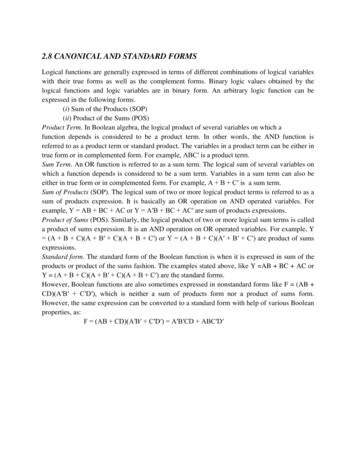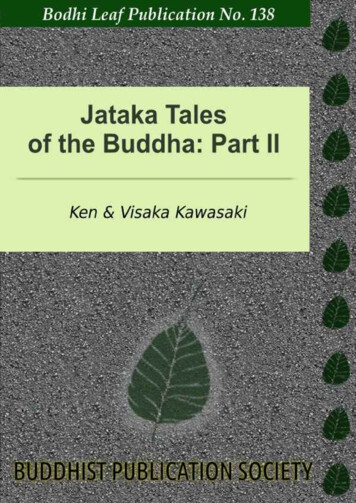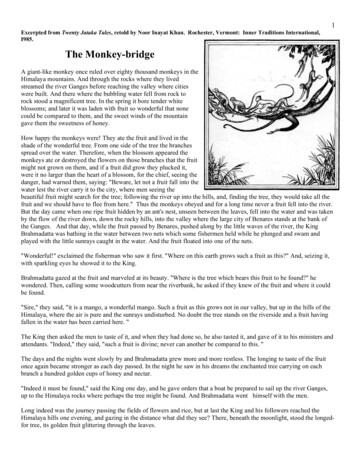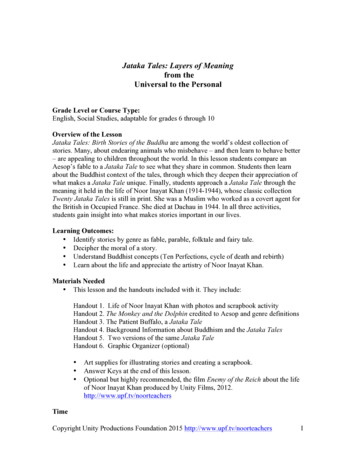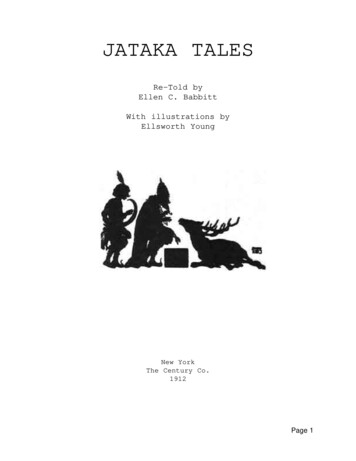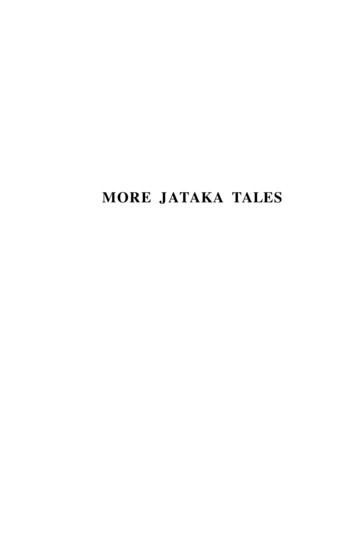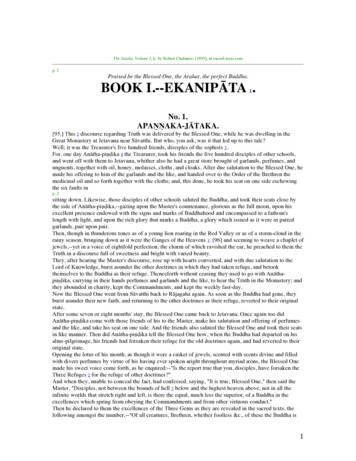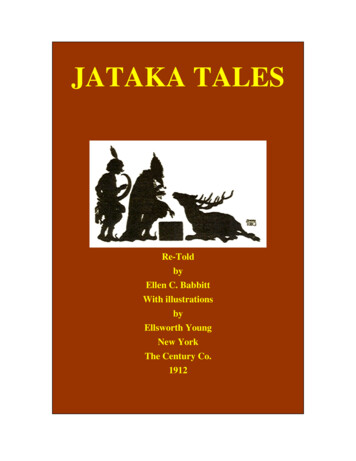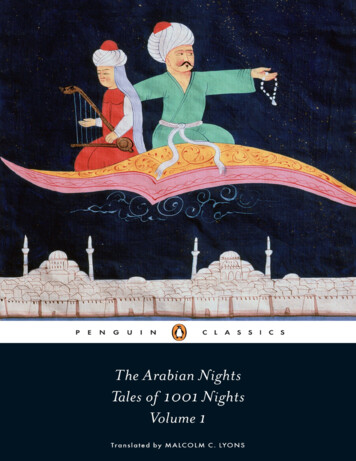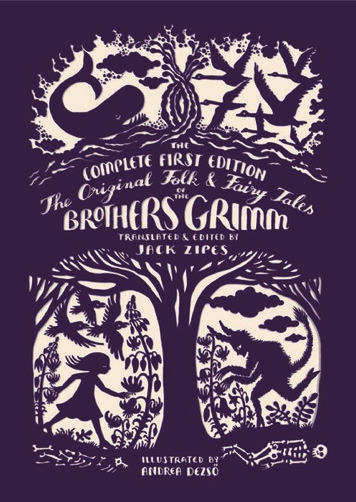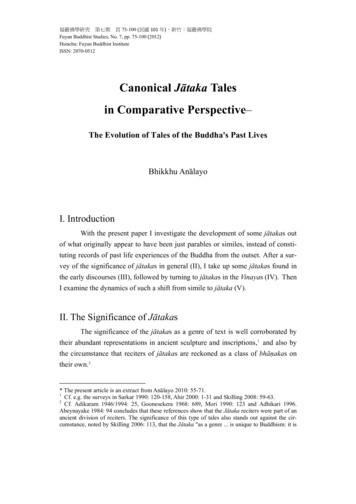
Transcription
福嚴佛學研究 第七期 頁 75-100 (民國 101 年),新竹:福嚴佛學院Fuyan Buddhist Studies, No. 7, pp. 75-100 (2012)Hsinchu: Fuyan Buddhist InstituteISSN: 2070-0512Canonical Jātaka Talesin Comparative Perspective–The Evolution of Tales of the Buddha's Past LivesBhikkhu AnālayoI. IntroductionWith the present paper I investigate the development of some jātakas outof what originally appear to have been just parables or similes, instead of constituting records of past life experiences of the Buddha from the outset. After a survey of the significance of jātakas in general (II), I take up some jātakas found inthe early discourses (III), followed by turning to jātakas in the Vinayas (IV). ThenI examine the dynamics of such a shift from simile to jātaka (V).II. The Significance of JātakasThe significance of the jātakas as a genre of text is well corroborated bytheir abundant representations in ancient sculpture and inscriptions,1 and also bythe circumstance that reciters of jātakas are reckoned as a class of bhāṇakas ontheir own.2* The present article is an extract from Anālayo 2010: 55-71.1Cf. e.g. the surveys in Sarkar 1990: 120-158, Ahir 2000: 1-31 and Skilling 2008: 59-63.2Cf. Adikaram 1946/1994: 25, Goonesekera 1968: 689, Mori 1990: 123 and Adhikari 1996.Abeynayake 1984: 94 concludes that these references show that the Jātaka reciters were part of anancient division of reciters. The significance of this type of tales also stands out against the circumstance, noted by Skilling 2006: 113, that the Jātaka "as a genre . is unique to Buddhism: it is
76福嚴佛學研究第七期/2012 年 4 月 20 日Tradition perceives the jātakas as records of the bodhisattva's experiencesand struggles during his gradual acquisition of the qualities that would enable himto become a Buddha.3 In fact the Mahāvastu, itself a repository of numerous jātakas, associates the delivery of such tales with the revealing of a bodhisattva'scourse of practice.4A well-known feature of jātaka tales is the integration of various ancientIndian fables, anecdotes and parables, which become jātakas through the simpleact of identifying one of the protagonists – usually though not always the mostheroic and exemplary one – with the Buddha in one of his former lives.5To mention just one example, a version of the Rāmāyaṇa found in the PāliJātaka collection presents the exploits of its hero Rāma as past life experiences ofnot found in Jaina or Brahmanical literature" (though the tales themselves often draw on a common ancient Indian narrative heritage). For a recent study of the Jātaka genre cf. also Appleton2010.3According to Feer 1875: 284: "les faits racontés dans nos jātakas tendent à un but unique: .graver dans l'esprit une règle de conduite, appuyée . sur l'exemple du Buddha". Kulasuriya 1996:19 explains that in the jātakas "the Bodhisatta, by his thoughts, words and deeds, reveals the pathto enlightenment". However, as pointed out by Cone 1977: xvii, the idea that "the Bodhisattva isthroughout these lives developing . [the] prerequisites for Buddhahood", "certainly postdatesmost of the stories" in the Jātaka collection. In fact, according to Cummings 1982: 20 "mostJātakas at the time of Bhārhut were simply used as parables in illustration of the Doctrine, and didnot yet carry any specific significance as stories of the Buddha's previous incarnations"; cf. alsoSarkar 1990: 5.4Senart 1882a: 104,12: bodhisatvacaritaṃ . jātakāparamateṣu kovidā deśayanti . īśvarā, "thesupreme ones [Buddhas], who are skilled in jātakas and other doctrines, teach the course of practice of a bodhisattva"; cf. also Edgerton 1953/1998: 240. On the bodhisattva career depicted in theTheravāda canonical Jātaka collection involving only males cf. the study by Appleton 2011.5This tendency has been noted by several scholars. Thus e.g. Alsdorf 1977: 25 points out that themajority of the Pāli jātaka verses are, if not pre-Buddhist, at least non-Buddhist, "die übergroßeMehrzahl der Jātaka-Gāthās [ist], wenn nicht vor-, so doch jedenfalls unbuddhistisch"; cf. alsoNorman 1983: 79. Regarding jātaka prose, Franke 1906 offers a survey of narrative materialshared in common between the Pāli Jātaka collection and the Mahābhārata. Kulasuriya 1996: 10notes that "stories of the Jātaka Book occur in the Pañcatantra, Kathāsaritsāgara and otherIndian story books. Some stories have parallels in the Mahābhārata and in the Rāmāyaṇa, and stillothers in Jaina literature". Laut 1993: 503 sums up that most jātakas are popular tales with aBuddhist veneer, "bei den meisten Jātakas handelt es sich . um volkstümliche Erzählungen .denen der Buddhismus als Firnis aufgetragen wurde". According to Winternitz 1920/1968: 90, thetendency of turning popular tales into jātakas had the result that at times rather worldly narrationsbecame 'Buddhist' even though they may have had little in common with Buddhist thought, "sokonnte jede noch so weltliche, dem buddhistischen Ideenkreise noch so ferne stehende Geschichtezu einer 'buddhistischen' werden".
Canonical Jātaka Tales in Comparative Perspective 77the bodhisattva.6 The same holds for a Chinese version of this tale,7 whereasanother Chinese version does not take the form of a jātaka.8 Similar variationscan be found with other manifestations of this tale that have made their way intovarious Asian cultures, which only at times appear as a jātakas.96This is the Dasaratha-jātaka, Jā 461, whose prose at Jā IV 130,19 identifies Rāma with thebodhisattva. Jacobi 1893/1970: 84-93 (in reply to Weber 1870) offers several arguments for considering the prose narration of the Dasaratha-jātaka to be an adaptation of an already existingversion of the Rāmāyaṇa. The two most salient points are: a) Sītā is introduced as Rāma's sister,even though from the outset she carries the epithet devī and at the end of the tale she marries Rāma(Przyluski 1936: 183, however, takes this to be an original element); b) the narration of the kinggranting a boon to his second wife becomes superfluous, as he does not comply with her request tomake her son crown prince instead of Rāma. On this topic cf. also Senart 1882b: 317 note 1, Sircar1976, Brockington 1985: 260 and Gombrich 1985: 434f. Lüders 1897/1940: 35-40 makes the important point that, what holds for the prose, does not apply to the verses; cf. also Winternitz 1908:434. For pictorial representations of Rāma apparently just about to go into exile, documenting thepopularity of this tale, cf., e.g., Longhurst 1938: 49-51 and plate 45a, Ray 1965 plate 18, Murthy1987: 7-9, Lal Nagar 1993: 143-145 and plates 39-41and Rama 1995: 108-110 and plate 40.7T 152 at T 3, 27b11, trsl. Chavannes 1910: 178.8T 203 at T 4, 447a16, trsl. Lévi 1903: 279-281 and Willemen 1994: 6-9, where none of the protagonists is identified with the bodhisattva.9A Burmese version identifies Rāma with the bodhisattva, Thein Han 1963: 78. In Cambodianversions of the tale (trsl. Martini 1978 and Pou 1977 and 1982), though Rāma is a manifestation ofViṣṇu, cf. Hak 1969: 35, he is nevertheless also identified with the bodhisattva (this has beenpointed out by Martini 1952: 68f and 1961: 354, cf. also Pou 1975: 356-359). An Indonesianversion of the Rāmāyaṇa (summarized in Stutterheim 1925: 66-80) does not take the form of ajātaka. In a Japanese version, Rāma is identified with the bodhisattva, cf. Hara 1980/1989: 335. AKhotanese version (ed. and trsl. Bailey 1940: 376 and 571) is ambivalent since, though it probablydoes identify Rāma with the bodhisattva (cf. Bailey 1939b: 464 and Maggi 2009: 367), it couldalso be taken to imply that Rāma was Maitreya in a former life while his brother Lakṣmaṇa wasthe bodhisattva (cf. Warder 1988: 636). In any case, the Khotanese version does take the form of ajātaka. A Lao version does identify Rāma with the bodhisattva (cf. Dhani Nivat 1969: 86 or thetrsl. in Sahai 1996: 326); whereas another Lao version (trsl. in Sahai 1976: 34-74; cf. also Deydier1952) does not take the form of a jātaka. Malaysian versions (summarized in Stutterheim 1925:28-63 or Zieseniss 1928: 7-64) do not take the form of a jātaka (though similar to the Dasaratha-jātaka, mentioned above in note 6, here Sītā is also Rāma's sister, cf. Kats 1926: 583). A SriLanka version described in Godakumbura 1946 also does not appear to be a jātaka (on the generaldearth of Rāmāyaṇa tales in Sri Lanka cf. Bechert 1978: 230f). A Thai version of the Rāmāyaṇa(trsl. in Velder 1962, summary in Puri 1940/1998) "is not presented as an incident in a previouslife of the Buddha", as noted by Reynolds 1991: 56. Among the manuscripts of a Tibetan versionof the Rāmāyaṇa (Balbir 1963 and de Jong 1971/1994; cf. also the survey in Lalou 1936 and deJong 1972/1994: 4-10), the final part of the story, which in jātakas usually provides an identification, is not preserved; de Jong 1983/1994: 57 notes that in a 15th century version of the tale, Rāmais identified with "a divinity of the Sa–skya school", which would thus exclude him being identified with the bodhisattva. A version of the Rāmāyaṇa in Uigur (on which cf. also Laut 1996: 198)does not provide an identification, though in this case this is due to the circumstance that the textonly gives an abbreviated summary of the tale (ed. and trsl. Zieme 1978: 28 and 30). For a comparative survey of Rāmāyaṇa tales in Buddhist literature cf. e.g. Desai 1970; for a study of Jain
78福嚴佛學研究第七期/2012 年 4 月 20 日III. Jātakas in the Early DiscoursesFor a proper appreciation of the formation of jātakas, of particular interestare those stories that are already found among the early discourses and in theVinaya, which take us to the beginning stages of jātaka literature.10 In what follows, I survey several examples that illustrate how some of these stories originated.11In his study of the jātaka genre, Rhys Davids (1903/1997: 194) takes up atale found in a discourse from the Saṃyutta-nikāya.12 In agreement with its Saṃyukta-āgama counterpart,13 this discourse reports the Buddha narrating how aquail strays outside of its proper resort and is thereupon caught by a falcon. Themoral of the story is that, just as the quail should have kept to its proper resort, sothe monks should keep to the practice of mindfulness as their proper resort inorder to withstand Māra.While in the discourse versions in the Saṃyutta-nikāya and in the Saṃyukta-āgama the whole story takes the form of a parable, in the Pāli Jātaka collectionthe same tale is a jātaka, which identifies the clever quail with the bodhisattva.14Rhys Davids (1903/1997: 195) comments that "there can be no question as towhich is the older document; for the Jātaka quotes as its source, and by name andchapter, the very passage in the Saṃyutta in which the fable originally occurs". Aversions of the Rāmāyaṇa cf. e.g. Kulkarni 1990. Raghavan 1975: 161 concludes his comparativestudy of various versions of the tale by commenting that "in some of the areas of South-East Asia,a slight Buddhistic adjustment, by making Rāma a Bodhisattva, has been adopted", just as in otherversions the tale is adjusted to Islamic thought; cf. also Barrett 1963.10Von Hinüber 1998: 187 notes that such individual "Ur-jātakas" found in the Pāli discoursesshare as a distinct characteristic that they are entirely in prose. In contrast, the Pāli canon's Jātakacollection is in verse, with prose narrations provided only in its commentary.11In the notes to my survey of selected jātaka tales, I do not mention well-known translationssuch as e.g. Cowell 1895-1907/2000 of the Pāli Jātaka collection or Jones 1949-1956/1973-1978of the Mahāvastu, but only translations that I assume are less well-known. I also do not aim at anexhaustive survey of relevant publications, as in the context of the present paper I can only scratchthe surface of the fascinating topic of how these jātaka tales developed in literature and art.12SN 47.6 at SN V 146,18.13SĀ 617 at T 2, 172c25.14This is the Sakuṇagghi-jātaka, Jā 168 at Jā II 60,23.
Canonical Jātaka Tales in Comparative Perspective 79version of this tale found in an Udāna collection preserved in Chinese agrees withthe two discourses in as much as it does not identify any of the animals in thisstory with the bodhisattva.15In the context of a study of the history of the Buddhist canon, Oldenberg(1912: 192) draws attention to two tales found in the Pāyāsi-sutta of theDīgha-nikāya, which recur similarly in a Dīrgha-āgama and a Madhyama-āgamaversion of this discourse. The setting at the background of these two tales is adiscussion between a sceptic and a Buddhist monk. During this discussion, themonk employs several examples to illustrate his arguments. One of theseexamples contrasts a clever caravan leader to a foolish one,16 another describeshow someone tries to cheat when playing dice.17Both tales also occur in the Pāli Jātaka collection, which identifies thechief protagonist in each parable with the bodhisattva.18 As the Pāyāsi-sutta andits Madhyama-āgama parallel explicitly introduce these tales as "parables",19 itcan safely be assumed that they became jātakas only at a later time. For the15T 212 at T 4, 695a12; cf. also T 2122 at T 53, 784b19 and T 2123 at T 54, 74a11 (here and below,unless otherwise indicated, references are to the beginning of the tale).16DN 23 at DN II 342,20, DĀ 7 at T 1, 45c6 and MĀ 71 at T 1, 529c25.17DN 23 at DN II 348,19, DĀ 7 at T 1, 46b21 and MĀ 71 at T 1, 530b28.18These are the Apaṇṇaka-jātaka, Jā 1 at Jā I 106,9, and the Litta-jātaka, Jā 91 at Jā I 380,25. Theidentification of the clever caravan leader with the bodhisattva can also be found in T 203 at T 4,466a2 (the trsl. by Chavannes 1911b: 32 does not include this final part); and in the (Mūla-)Sarvāstivāda Vinaya, D 1 kha 245a2 or Q 1030 ge 229a4 (for a summary cf. Panglung 1981: 44). Onthe game of dice in ancient India cf. Lüders 1940. For a representation in art of game players thatat times has been thought to be related to the Litta-jātaka cf., e.g., Cunningham 1879: 94f andplate XLV.9, Barua 1934/1979: 95
Canonical Jātaka Tales in Comparative Perspective 77 the bodhisattva.6 The same holds for a Chinese version of this tale,7 whereas another Chinese version does not take the form of a jātaka.8 Similar variations can be found with other manifestations of this tale that have made their way into
